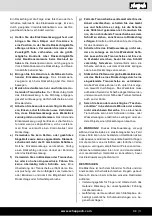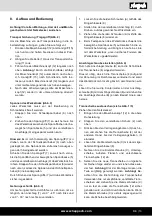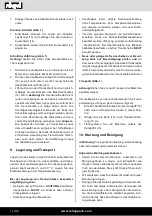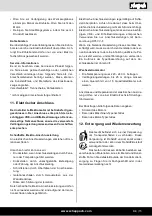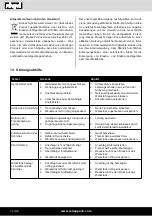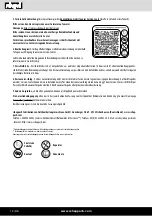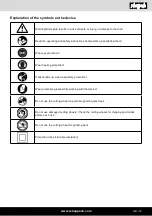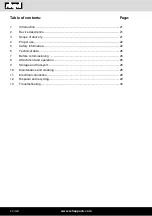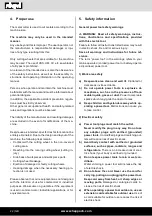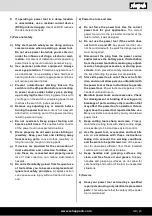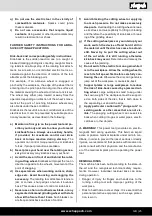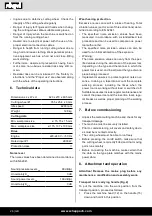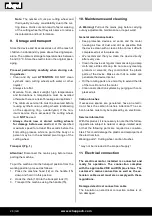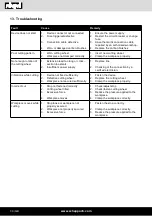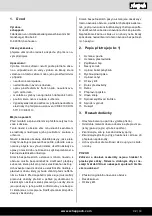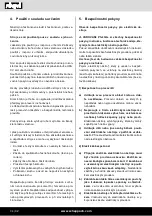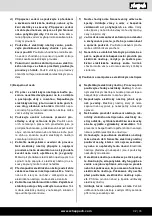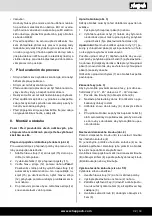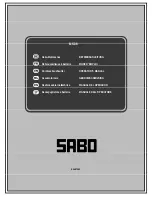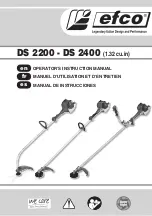
www.scheppach.com
GB | 25
f) Avoid blocking the cutting wheel or applying
too much pressure.
Do not make excessively
deep cuts.
Overloading the cutting wheel increas-
es its stress and susceptibility to tilting or blocking
and therefore the possibility of kick-back or break
-
ing of the grinding wheel.
g) If the cutting wheel jams or you interrupt your
work, switch the device off and hold it still in
the material until the disc has come to a stand
-
still.
Never try to pull the cutting wheel out
of the cut while it is still running, otherwise
kick-back may occur.
Determine and remedy the
cause of the jamming.
h) Do not switch the electric tool on again while it
is in the workpiece.
Allow the cutting wheel to
reach its full speed first before carefully con
-
tinuing the cut.
Otherwise the disc can get stuck,
jump out of the workpiece or cause kick-back.
i) Support plates or large workpieces to reduce
the risk of kick-back caused by a jammed cut
-
ting wheel.
Large workpieces tend to sag under
their own weight. The workpiece must be support-
ed on both sides of the disc, that is both close to
the separating cut and at the edge.
j) Apply particular caution with “plunge cuts” in
existing walls or other areas that are not vis
-
ible.
The plunging cutting wheel can cause kick-
back when cutting into gas or water pipes, electri-
cal lines or other objects.
m
WARNING!
This power tool generates an electro-
magnetic field during operation.
This field can impair
active or passive medical implants under certain con-
ditions.
In order to prevent the risk of serious or deadly
injuries, we recommend that persons with medical im
-
plants consult with their physician and the manufactur
-
er of the medical implant prior to operating the power
tool.
RESIDUAL RISKS
The machine has been built according to the state-of-
the-art and the recognised technical safety require
-
ments. However, individual residual risks can arise
during operation.
•
Danger of injury for fingers and hands due to the
running cutting tool with improper guiding of the
workpiece.
• Risk to health due to steel chips. It is essential that
personal protective equipment, such as eye protec
-
tion, is worn.
q) Do not use the electric tool in the vicinity of
combustible materials.
Sparks could ignite
these materials.
r) Do not use accessories that require liquid
coolants.
Using water or other liquid coolants may
result in electrocution or shock.
FURTHER SAFETY INSTRUCTIONS FOR ABRA-
SIVE CUTTING APPLICATIONS
Kick-back and corresponding safety instructions
Kick-back is the sudden reaction due to a caught or
blocked rotating grinding disc. Getting caught or block-
ing leads to an abrupt stop of the rotating tool attach-
ment. As a result, an uncontrolled electric tool is ac-
celerated against the direction of rotation of the tool
attachment at the blocking point.
For example, if an abrasive wheel is snagged or
pinched by the workpiece, the edge of the wheel that is
entering into the pinch point can dig into the surface of
the material causing the wheel to climb out or kick out.
The wheel may either jump toward or away from the
operator, depending on direction of the wheel’s move-
ment at the point of pinching.
Abrasive wheels may
also break under these conditions.
Kickback is the result of incorrect or deficient use of the
electrical tool.
It can be prevented by suitable precau
-
tionary measures, as described in the following.
a) Maintain a firm grip on the power tool and po
-
sition your body and arm to allow you to resist
kickback forces.
Always use auxiliary handle,
if provided, for maximum control over kick
-
back or torque reaction during start-up.
The
operator can control torque reactions or kickback
forces, if proper precautions are taken.
b) Never place your hand near the rotating acces
-
sory.
Accessory may kickback over your hand.
c) Avoid the area in front of and behind the rotat
-
ing cutting wheel.
Kickback will propel the tool in
direction opposite to the wheel’s movement at the
point of snagging.
d) Use special care when working corners, sharp
edges etc. Avoid bouncing and snagging the
accessory.
The rotating tool attachment tends to
jam at corners, sharp edges or when it bounces
back. This causes a loss of control or kick-back.
e) Never use a chain or toothed saw blade, or any
segmented diamond grinding wheel with slots
of a width of more than 10 mm.
Such blades cre-
ate frequent kickback and loss of control.

